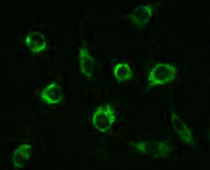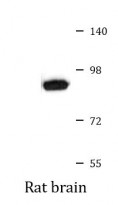ARG42676
anti-APLP2 antibody
anti-APLP2 antibody for ICC/IF,Western blot and Human,Mouse,Rat
Overview
| Product Description | Rabbit Polyclonal antibody recognizes APLP2 |
|---|---|
| Tested Reactivity | Hu, Ms, Rat |
| Tested Application | ICC/IF, WB |
| Host | Rabbit |
| Clonality | Polyclonal |
| Isotype | IgG |
| Target Name | APLP2 |
| Antigen Species | Human |
| Immunogen | Recombinant fusion protein corresponding to aa. 340-450 of Human APLP2 (NP_001135750.1). |
| Conjugation | Un-conjugated |
| Alternate Names | Amyloid-like protein 2; APPL2; APLP-2; CDEI box-binding protein; APPH; CDEBP; Amyloid protein homolog |
Application Instructions
| Predict Reactivity Note | Human | ||||||
|---|---|---|---|---|---|---|---|
| Application Suggestion |
|
||||||
| Application Note | * The dilutions indicate recommended starting dilutions and the optimal dilutions or concentrations should be determined by the scientist. |
Properties
| Form | Liquid |
|---|---|
| Purification | Affinity purified. |
| Buffer | PBS (pH 7.3), 0.02% Sodium azide and 50% Glycerol. |
| Preservative | 0.02% Sodium azide |
| Stabilizer | 50% Glycerol |
| Storage Instruction | For continuous use, store undiluted antibody at 2-8°C for up to a week. For long-term storage, aliquot and store at -20°C. Storage in frost free freezers is not recommended. Avoid repeated freeze/thaw cycles. Suggest spin the vial prior to opening. The antibody solution should be gently mixed before use. |
| Note | For laboratory research only, not for drug, diagnostic or other use. |
Bioinformation
| Database Links | |
|---|---|
| Gene Symbol | APLP2 |
| Gene Full Name | amyloid beta (A4) precursor-like protein 2 |
| Background | This gene encodes amyloid precursor- like protein 2 (APLP2), which is a member of the APP (amyloid precursor protein) family including APP, APLP1 and APLP2. This protein is ubiquitously expressed. It contains heparin-, copper- and zinc- binding domains at the N-terminus, BPTI/Kunitz inhibitor and E2 domains in the middle region, and transmembrane and intracellular domains at the C-terminus. This protein interacts with major histocompatibility complex (MHC) class I molecules. The synergy of this protein and the APP is required to mediate neuromuscular transmission, spatial learning and synaptic plasticity. This protein has been implicated in the pathogenesis of Alzheimer's disease. Multiple alternatively spliced transcript variants encoding different isoforms have been identified. [provided by RefSeq, Aug 2011] |
| Function | May play a role in the regulation of hemostasis. The soluble form may have inhibitory properties towards coagulation factors. May interact with cellular G-protein signaling pathways. May bind to the DNA 5'-GTCACATG-3'(CDEI box). Inhibits trypsin, chymotrypsin, plasmin, factor XIA and plasma and glandular kallikrein. Modulates the Cu/Zn nitric oxide-catalyzed autodegradation of GPC1 heparan sulfate side chains in fibroblasts (By similarity). [UniProt] |
| Cellular Localization | Cell membrane; Single-pass type I membrane protein. Nucleus. [UniProt] |
| Calculated MW | 87 kDa |
| PTM | The BPTI/Kunitz inhibitor domain is O-glycosylated. [UniProt] |
Images (2) Click the Picture to Zoom In







